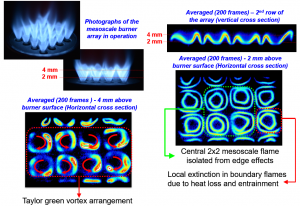At the core of our mission is the development and application of advanced laser and optical diagnostics which will enable probing the physicochemical dynamics in energy conversion systems as well as machine learning based analysis. The scope of our work in this domain span a wide spectrum from absorption diode lasers, multi-phase spray imaging, to novel high space spatially resolved measurement techniques.
Recently, we have been collaborating with the Air Force Research Laboratory to develop novel high speed imaging strategies that can provide a unique insight into turbulent combustion processes relevant to practical propulsion systems. One of the most recent innovations is to use a novel CH C-X transition to measure flame front evolution. The enhanced efficiency of this transition enables measurements to be made at frame rates exceeding tens of kHz as shown in the video below.
CH C-X Transition in turbulent flame
Machine Learning Application
We are actively researching areas where machine learning can aid us to better understand reactive flow dynamics. The link below is an example of unsupervised upshifting of frame rates from 5 kHz (left; experimental) to 80 kHz (right) using GAN-based vision AI. The enhanced time-resolution permits improved flame feature tracking and statistical analyses.
Link: machine learning based frame upgrading
Mesoscale Combustor Array: Combustion Stability
We have been funded by the Office of Naval Research to investigate the potential for mesoscale combustor arrays to be integrated into the next generation of microscale gas turbine systems for the Navy. The mesoscale array consists of a field of counter rotating swirl stabilized flames in an array pattern that will enhance combustion efficiency and stability.

Microscale Combustor Array: Laser and Optical Diagnostics
We have been conducting laser and optical diagnostics on a model combustor array (shown above) to determine the extension of the lean flammability limit and improvements in combustion stability. An acoustically forced flow is inserted into the combustor which is subsequently imaged using high speed PLIF at framerates of ≥10 kHz. In order to quantify the combustion instability, we have also been developing the application of dynamics mode decomposition to analyze the growth of different frequency modes in the flame.

